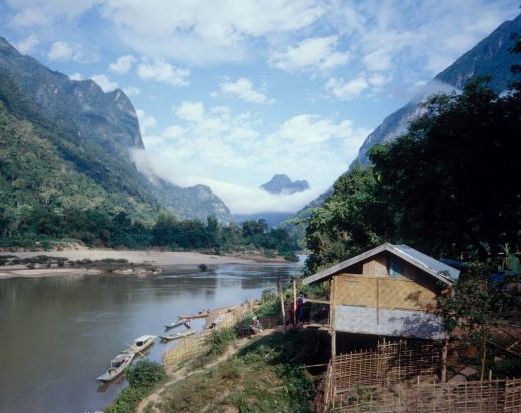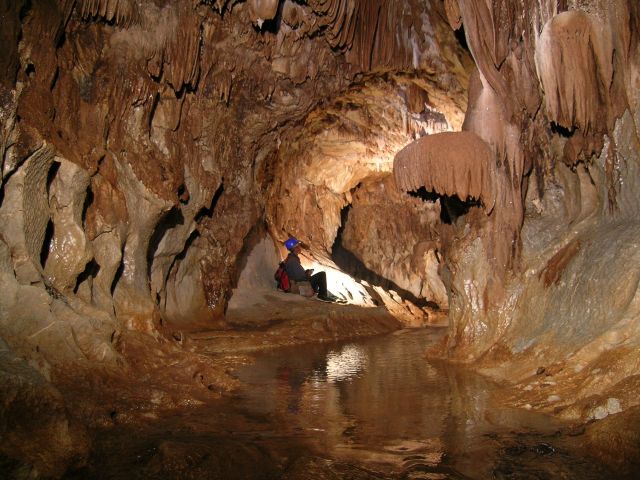



    |
Northern Lao - European |
|
Laos 2005 Expedition to Phou Khoun and Vieng
Phouka Expedition time: 1.-13. February 2005 The purpose of this expedition was to explore new areas in Northern Laos. A short visit was done to Phou Khoun at the main junction of route 7 and 13. The government wanted to open up a cave for tourists. The main part of the expedition focused on the area of Vieng Phouka. There an European Union sponsored micro project promoted ecotourism which included visits to caves. This resulted in the survey of the Nam Eng cave. The so far longest cave in Northern Laos. In total 4 caves with a length of 8.7 km were surveyed and mapped. Phou Khoun Area The T-juntion of the north-south road 13 with the road 7 to the Plain of the Jars marks the location of the village of Phou Khoun. It takes 3 hours on the winding road 13 from Luang Phrabang until Phou Khoun is reached. The area was a showplace of Hmong rebels and a long time considered to be unsafe. Only recently the situation relaxed and the first time a permission was obtained in 2005 to visit the caves nearby. Nevertheless the local authorities insisted on certain safety measures and 3 soldiers and 2 policemen equipped with machine gun and pistols escorted us to the cave on the first day. The Tham Seua (Tiger cave) – Nam Lot (Tunnel cave) system was originally known as two separate caves which could be successfully linked during the survey to one 2.7 km long system. It takes a 10 minute walk from the T-junction along the road 7 to about 200 m beyond the hospital until a footpath to the left is reached which descends to the valley with the caves. The entrances are found after another 45 minutes at the very end of the valley at the base of a north-east to south-west stretching mountain ridge. The system consists of the maze like Tham Seua that connects to the main river passage of Tham Nam Lot. A 60 m higher upper level with three separate entrances has several interlinked and richly decorated chambers. One passage descends steeply to the river passage. The river crosses the mountains and exits as a spring between boulders and blocks. An intense search for a crawl that connects to the river passage failed. Other caves further away were reported, but located in still unsafe areas and out of limits for the time being.
Vieng Phouka Area The district village of Vieng Phouka is situated in the Luang Nam Tha province half-way along the road from Luang Nam Tha towards Huay Xai at the Thai border. In a few years the region will experience an economic boost due to a highway that is currently in construction between Thailand and China. Caves play an important role in the Vieng Phouka based eco-tourism project from the European Community and are visited in combination with trekking activities. The 2005 speleological investigations of the Dutch-German team were logistically supported in a generous way by providing transport and well-trained guides. Due to the excellent conditions the 2005 cave investigations led to important discoveries within a period of one week only. The Tham Nam Eng is the best known cave in the area and used for eco-tourism. It is mentioned in several international guide books and also indicated on tourist maps from Laos. The guides pay great attention on the protection of the cave which is therefore looked. Waste has to be carried out and nothing should be left in the cave. Despite the intense use of the cave no systematic survey has been done and the guides visited only the known areas. Their fear to get lost kept them out of any new passages and exploration. The cave is reached by a 1 hour drive on the dusty main road from Vieng Phouka to Luang Nam Tha just a few km further north from name giving village Ban Eng. It takes only 10-15 minutes to walk from the road eastwards to the base of the mountain ridge that hosts the Nam Eng system. It consists of the upper fossil cave of 3.1 km length and the lower active resurgence cave of 3.5 km length. Some of these passages are situated less than 100 metres from each other on a comparable level. However, no link between both caves was found. There are also several vertical shafts that ascend from the main passage of Tham Nam Eng (resurgence) that may connect both caves. Tham Nam Eng resurgence cave drains massive water during the wet season. The walls nearly of the complete cave show scallops with a diameter less than 1 cm. Dripstone formations are rare in Tham Nam Eng resurgence cave and can be found in the upper parts of higher passages only. Other caves surveyed in the area are the Tham Nam Lot (“Tunnel cave”, 1.4 km) and Tham Phou Pasat (645 m). They are located in an isolated ridge about 2,5 km north of Vieng Phouka. The active river cave Tham Nam Lot crosses the ridge and has at least 5 entrances. The Vieng Phouka area offers probably the biggest potential in northern Laos. Several other caves were reported in the district unfortunately less close located to roads. The 3 hour intense jungle hike to Tham Phoulan on the last day surprised with a about 250 m long, 80 wide and 100 m high huge chamber. There was no time to survey in order to be back before sun set. |